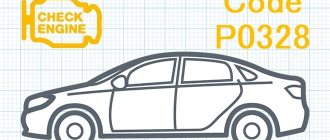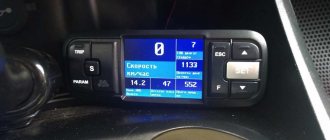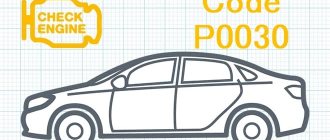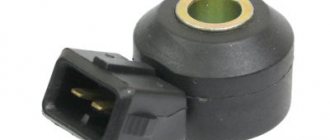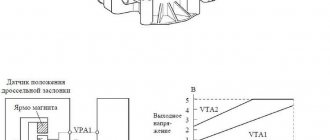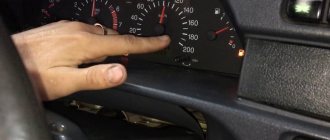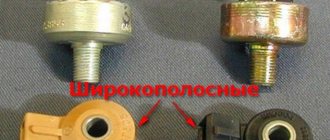A detonation error can be caused by various reasons - a low or very high signal from it to the electronic engine control unit (ECU), a circuit error, an out-of-range voltage or signal range, as well as a complete failure of the knock sensor (hereinafter referred to as DS), which happens very rarely. However, in any case, the Check Engine light on the car’s dashboard is activated, symbolizing the occurrence of a malfunction, and when the engine is running, there is a deterioration in dynamics, dips in speed and an increase in fuel consumption. Often, “dzhekichana” can be detected as a result of using bad fuel, but often it’s all about the contact and wiring of the motor. The error code can be easily read using diagnostic scanners. For an explanation of all knock sensor errors, indicating the causes and methods for eliminating them, see below.
There are actually four knock sensor errors - P0325, P0326, P0327 and P0328. However, the conditions for their formation, external signs, and methods of elimination are very similar, and sometimes identical. These diagnostic codes cannot specifically report the cause of the failure, but they can point you in the direction of troubleshooting the knock sensor circuit. Quite often, this is a bad contact in connecting the sensor to the connector or in the contact of its surface to the engine, but sometimes the sensor really fails (cannot be repaired, only replacement is possible). Therefore, first of all, the operation of the engine knock sensor is checked.
Technical description and interpretation of error P0327
This diagnostic trouble code (DTC) is a generic code. The P0327 code is considered a common code because it applies to all makes and models of vehicles. Although the specific repair steps may vary slightly depending on the model.
The knock sensor (KS) is installed in the engine and is used to detect spark knock. When sparking or knocking occurs, the sensor produces a voltage signal that is sent to the PCM. The PCM will then adjust the ignition timing to protect the engine.
Inside, the knock sensor is a piezoelectric crystal. This crystal is used to create alternating voltage when vibrated. That is, it is a kind of converter that converts changes in physical quantities into an electrical signal.
The knock sensor (KS) usually has two wires. One supplies 5 volts to the sensor, and the second transmits parameters from the knock sensor to the PCM; it serves as a signal.
The sensor signal wire tells the PCM when detonation occurs and how severe it is. After this, the PCM retards the ignition timing to avoid premature detonation. Most PCMs are capable of detecting spark knock trends in an engine during normal operation.
Trouble code P0327 means the knock sensor circuit is low. That is, the PCM has detected a problem with the knock sensor or its circuit. Some vehicles may be equipped with multiple knock sensors. This code is for sensor 1 on bank 1, cylinder #1 side of the engine.
Additional recommendations
Finally, it is worth noting several interesting facts that will help car enthusiasts get rid of problems with the knock sensor and directly with the phenomenon of fuel detonation.
Firstly, you should always take into account that there are sensors of varying quality (from different manufacturers) available on the market. Car enthusiasts have often noted that cheap, low-quality knock sensors not only do not work correctly, but also quickly fail. Therefore, try to buy quality products.
Secondly, when installing a new sensor, always use the correct tightening torque. Accurate information can be found in the car manual or on specialized resources on the Internet. Direct tightening must be done using a torque wrench. Moreover, the installation of the DD should be done not on a bolt, but on a stud with a nut. It will prevent the sensor from loosening its mount over time due to vibration. After all, when a standard bolt is loosened, it or the sensor itself can vibrate in its seat and falsely provide information that there is detonation.
As for checking the sensor, one of these procedures is checking its internal resistance. This can be done using a multimeter set to resistance measurement mode (ohmmeter). It will be different for each sensor, but the approximate value will be around 5 MOhm (should not be too low or even zero, as this directly indicates its failure).
Also, if the above errors occur, you should always check the condition of the knock sensor wiring. When exposed to high temperatures, it can become brittle and damaged over time. It is sometimes noted on forums that simply wrapping the wiring with insulating tape can solve the error problem. But for this it is advisable to use heat-resistant electrical tape and insulate it in several layers.
Some car owners note that one or several of the errors listed above may occur if they fill the car with low-quality gasoline with an octane rating lower than that prescribed for the engine. Therefore, if after checking you do not find any faults, just try changing the gas station. This has helped some car enthusiasts.
In rare cases, you can do without replacing the knock sensor. Instead, you can try to restore its functionality. In particular, using sandpaper and/or a file, it is necessary to clean its metal surface in order to remove dirt and rust (if any) from it. This way you can increase (restore) the mechanical contact between the sensor and the cylinder block itself.
Another interesting observation is that the knock sensor may mistake extraneous sounds for detonation. An example would be a weakened fastening of the engine protection, due to which the protection itself rattles on the road, and the sensor may falsely trigger and transmit a signal to the ECU, which in turn increases the ignition angle, and “detonation” continues. In this case, the errors described above may occur.
In some car models, such errors may appear spontaneously, and they are difficult to reproduce. Indeed, in some cars the knock sensor is triggered only at a certain position of the crankshaft. Therefore, even when tapping the engine with a hammer, it may be impossible to reproduce the error and understand the reason. This information needs to be clarified further and it is better to contact a car service center for help.
Some modern vehicles have a rough road sensor that disables the knock sensor when the vehicle is driven on a rough road and the crankshaft becomes misaligned and produces a sound similar to fuel knocking. That is why checking the knock sensor with the engine running, when the engine is hit with something heavy, after which the engine speed drops, is not always correct. So it is better to check the value of the voltage it produces during mechanical impact on the engine.
Conclusion
As mentioned above, all four described errors are not critical, and the car can drive to a garage or car service station under its own power. However, this will be detrimental to the engine if fuel detonation occurs in the engine. Therefore, if such errors occur, it is still advisable to get rid of them as quickly as possible and eliminate the causes that caused them. Otherwise, there is a risk of complex breakdowns, which will lead to serious, and most importantly expensive, repairs.
Source
Symptoms of malfunction
The main driver symptom of P0327 is the MIL (Malfunction Indicator Light). It is also called Check engine or simply “check light”.
They can also appear as:
- The “Check engine” warning light on the control panel will light up (the code will be stored in memory as a malfunction).
- The motor can operate, but with reduced performance (drop in power).
- Jerking and detonation in the engine.
- Increased fuel consumption.
- There may be no symptoms other than a stored DTC.
Error P0327 is not considered very serious. When it appears, serious problems with the car's handling are unlikely to arise, but a slight drop in engine power is possible.
Typical breakdowns
Be sure to listen to how the engine operates as the load increases - if even the slightest metallic clatter appears, be sure to make a diagnosis.
Otherwise, you may experience the following problems:
- Burnout of the gasket under the cylinder head. When detonation occurs, the engine temperature increases.
- Destruction of the pistons, as they all corrode.
- Very often, elements of the crank mechanism and cylinder head are destroyed.
If you are driving your car up a hill and the gear is in high gear, be sure to monitor the engine. If you subject the engine to heavy loads, you will contribute to the appearance of detonation knocks. As a result, many elements of the car will fail, and this is the first step towards a major overhaul.
How to Troubleshoot or Reset Trouble Code P0327
Some suggested steps to troubleshoot and fix error code P0327:
- Visually inspect the electrical wires and connectors leading to the sensor.
- Check the continuity of the wiring from the PCM to the knock sensor wiring connector.
- Measure the resistance of the knock sensor and compare with factory specifications.
- If necessary, replace the knock sensor.
Please note that there are two types of knock sensors, resonant in the form of a barrel and broadband in the form of a ring-washer.
Diagnosis and problem solving
Begin your diagnosis by visually inspecting all system-related wiring harnesses and connectors. Inspect electrical circuits, sensors, and connectors that are contaminated with engine oil, coolant, or power steering fluid.
Petroleum-based liquids are known to corrode the protective insulation of wires and cause short circuits or open circuits. This may cause the P0327 code to appear.
Sensor test
To test an older style knock sensor, connect a multimeter set to AC voltage between the sensor output wire and ground. Tap the engine near the sensor. You should see the AC voltage reading on your DMM. Otherwise, the sensor is faulty and must be replaced.
To check the resonant type sensor, we connect a digital multimeter in the same way. But instead of knocking on the engine block. The fuel pump relay must be removed to prevent the engine from starting.
Crank the engine, shift into gear, and keep your foot on the brake. As soon as the car starts to run out of fuel, it will start knocking and stalling. You should then see the AC voltage output. Otherwise, the knock sensor is faulty and must be replaced.
Checking electrical circuits
If the knock sensor is working fine but the P0327 code is still on, you need to check the sensor circuit. Using a digital multimeter set to resistance, connect one side of the meter to the harness side of the sensor connector. And the other to the knock sensor input terminal on the PCM. This will check the continuity between the sensor and the PCM.
Now you need to check the grounding. Old style knock sensors are grounded through the sensor itself, while newer style knock sensors usually have a separate ground circuit. Connect the red lead of the multimeter to the positive terminal of the battery and the black lead to ground. You should see a reading of around 12 volts, indicating a good ground. Otherwise, you need to look for a circuit fault.
On which cars is this problem most common?
The problem with code P0327 can occur on different machines, but there are always statistics on which brands this error occurs more often. Here is a list of some of them:
- Audi (Audi q7, Audi TT)
- Chevrolet (Chevrolet Aveo, Lacetti, Silverado)
- Citroen (Citroen C4)
- Ford
- GMC Sierra
- Honda
- Infiniti (Infiniti fx35)
- Land Rover
- Mazda (Mazda 3, Mazda 6)
- Mitsubishi (Mitsubishi Pajero)
- Nissan (Nissan Almera, Pathfinder, Teana, X-Trail)
- Opel (Opel Astra)
- Peugeot (Peugeot 308)
- Pontiac (Pontiac Montana)
- Saturn
- Skoda (Skoda Octavia)
- Subaru (Subaru Forester)
- Suzuki (Suzuki Vitara, Grand Vitara, sx4)
- Toyota (Toyota Corolla, Prius, Yaris)
- Volkswagen (Volkswagen Passat, Polo Sedan, Tiguan, Touareg)
- VAZ 2110, 2112, 2114, 2115
- Gazelle Business, UMZ 4216
- Zaz
- Lada Vesta, Granta, Kalina, Largus, Niva, Priora, X-Ray
- UAZ Bukhanka, Patriot, ZMZ 409
With fault code P0327, you can sometimes encounter other errors. The most common ones are: P0135, P0171, P0174, P0325, P0326, P0328, P0329, P0330, P0331, P0332, P0333, P0334, P0420.
How to change a knock sensor
The process of replacing DD with VAZ 2114–2115, 2110–2112, as well as Priora, Grant and Kalina, is quite similar. For all of the listed cars, the knock sensor is located on the outside of the cylinder block, under the 2nd and 3rd spark plugs. Here are the step-by-step instructions:
- Disconnect the battery.
- Disconnect the power supply.
- Unscrew the DD fastening bolt (socket wrench 13 mm).
- We clean the mating surface on the block with fine sandpaper and degrease it with gasoline.
- Screw in the sensor and tighten the bolt to a torque (10–25 N×m).
- We connect the power supply.
Then we connect the battery. Using a diagnostic scanner or mobile application, we remove the error.
